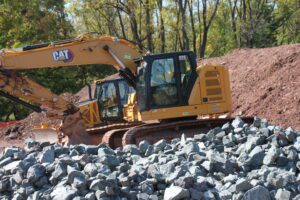
Excavators and front end loaders can be invaluable tools for increasing productivity at your construction site. It is important, however, to recognize the hazards associated with their use, and to take all necessary precautionary measures to protect workers and others who may be walking or working in the area. While accidents involving these types of equipment are similar to those involving tractors, the risk is increased by the addition of buckets, attachments, which increase the height and weight (thereby increasing risk of turnovers) and decrease the visibility from these machines (thereby increasing the risk of contact with people or objects).
Common accidents associated with excavators and front end loaders are: overturns, falls, run-overs, and contact with other people or objects. Due to the size and weight of this equipment, any accident is serious and injuries are often life threatening or fatal. Knowing the risk and addressing them are the first steps in employing proper safety guidelines for utilizing excavators and front end loaders.
Causes of Injuries Associated with Excavators & Front End Loaders
- Overturns, caused by turning uphill on a steep slope, or turning too fast on a downhill
slope. - Raising a loaded bucket too high, especially on uneven ground or while turning.
- Hitting a ditch, stump or hole while moving can cause a rollover, or cause a rider to be
ejected and run over. - Excavating unstable soil, undercutting a bank with the backhoe or operating too close
to the edge of a steep bank or excavation, can cause equipment roll-over. - Falls caused by slipping on the platform or steps while mounting or dismounting from the
equipment. - Equipment or loads falling on another person working too close or under a suspended
load. - Being struck by equipment which was started in gear, or was backing up without a
back-up alarm.
There are steps you can take to avoid these injuries. First and foremost, be aware, at all times, of your surroudings. This includes low hanging tree limbs, power lines, bridges, overpasses, or other obstacles. Determine location of all utilities (gas,electric, water, telephone, cable) before digging. Utilize state or local One Call System. Many of the causes above can be catalogued as not understanding how your surroundings will impact safety.
Other common safety tips include:
- Slow down on rough terrain, going up or down slopes, or when carrying a heavy load.
- Locate ditches, stumps debris, undercut banks before working in an area.
- Be aware of overhead exposures when carrying a high load.
- When excavating with a backhoe, never undercut the area below the stabilizers.
- Never allow extra riders.
- Never start a machine while “in gear”. Check your perimeter before starting.
- Keep all steps and platforms clean and free of debris.
In summary, operating an excavator or front end loader can increase productivity. However, each operator needs to be aware of the safety hazards associated with each piece of equipment used at the site. Take your time to be aware of your surroundings for safety. Always operate within the prescribed limits of the equipment. Remember to keep safety, first and foremost, in your mind at all times.
